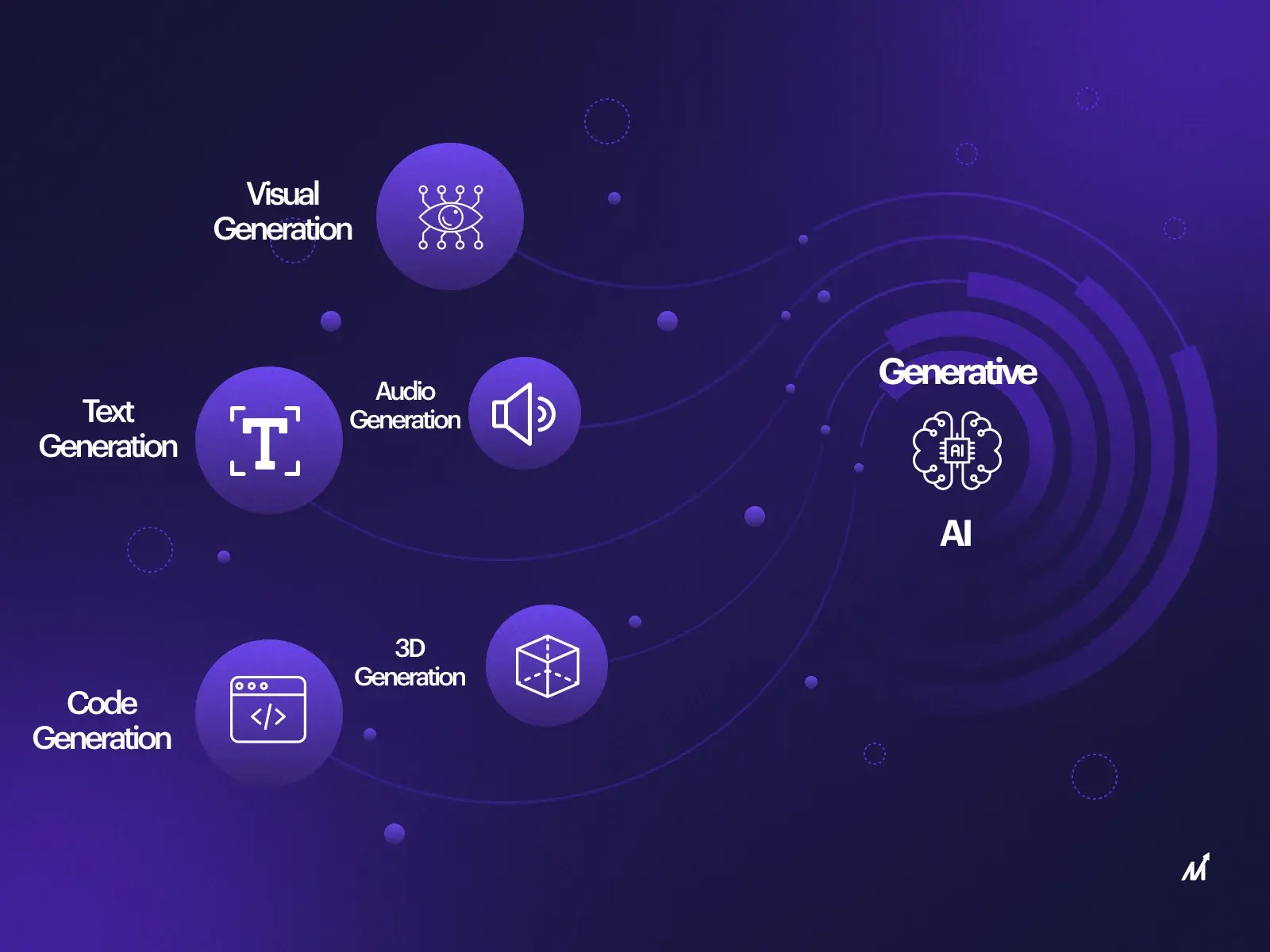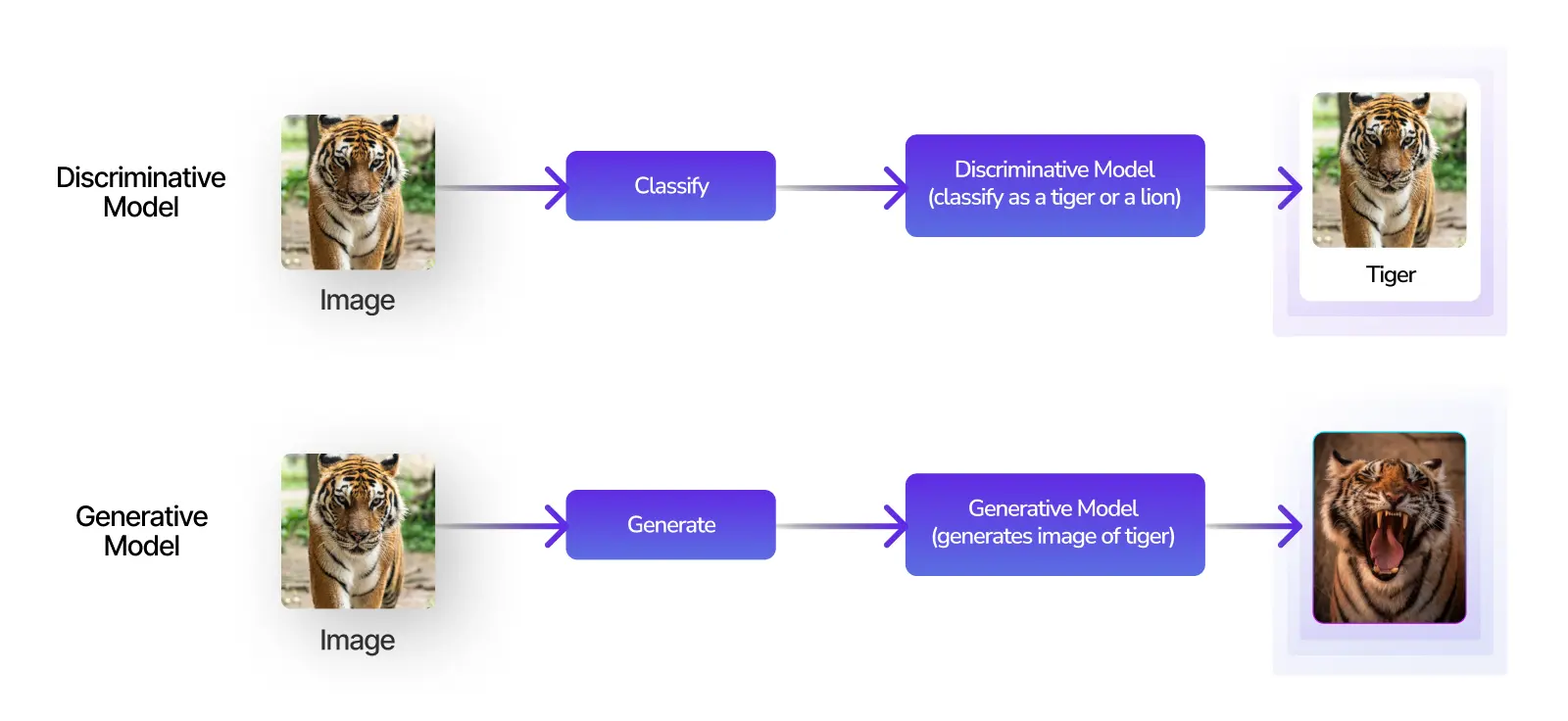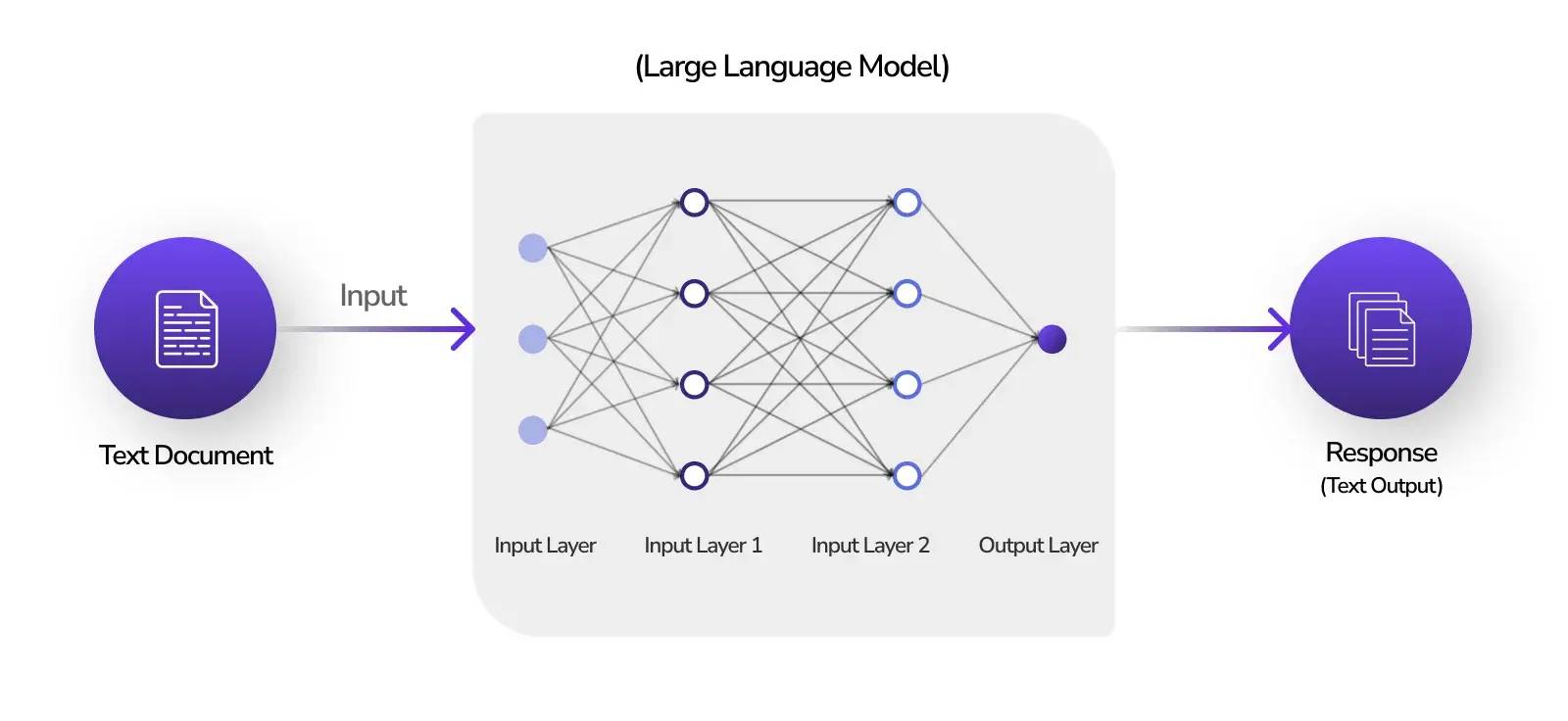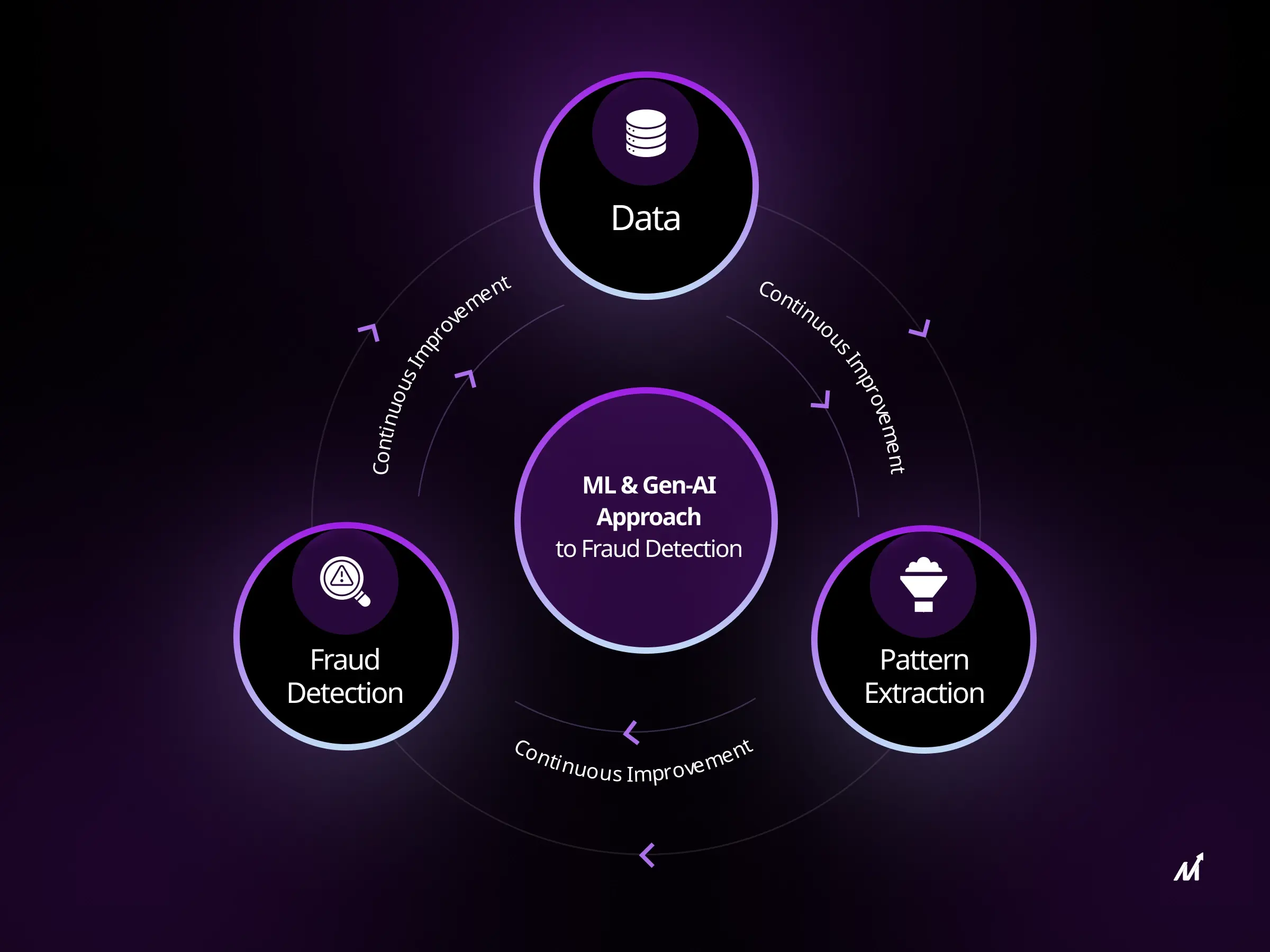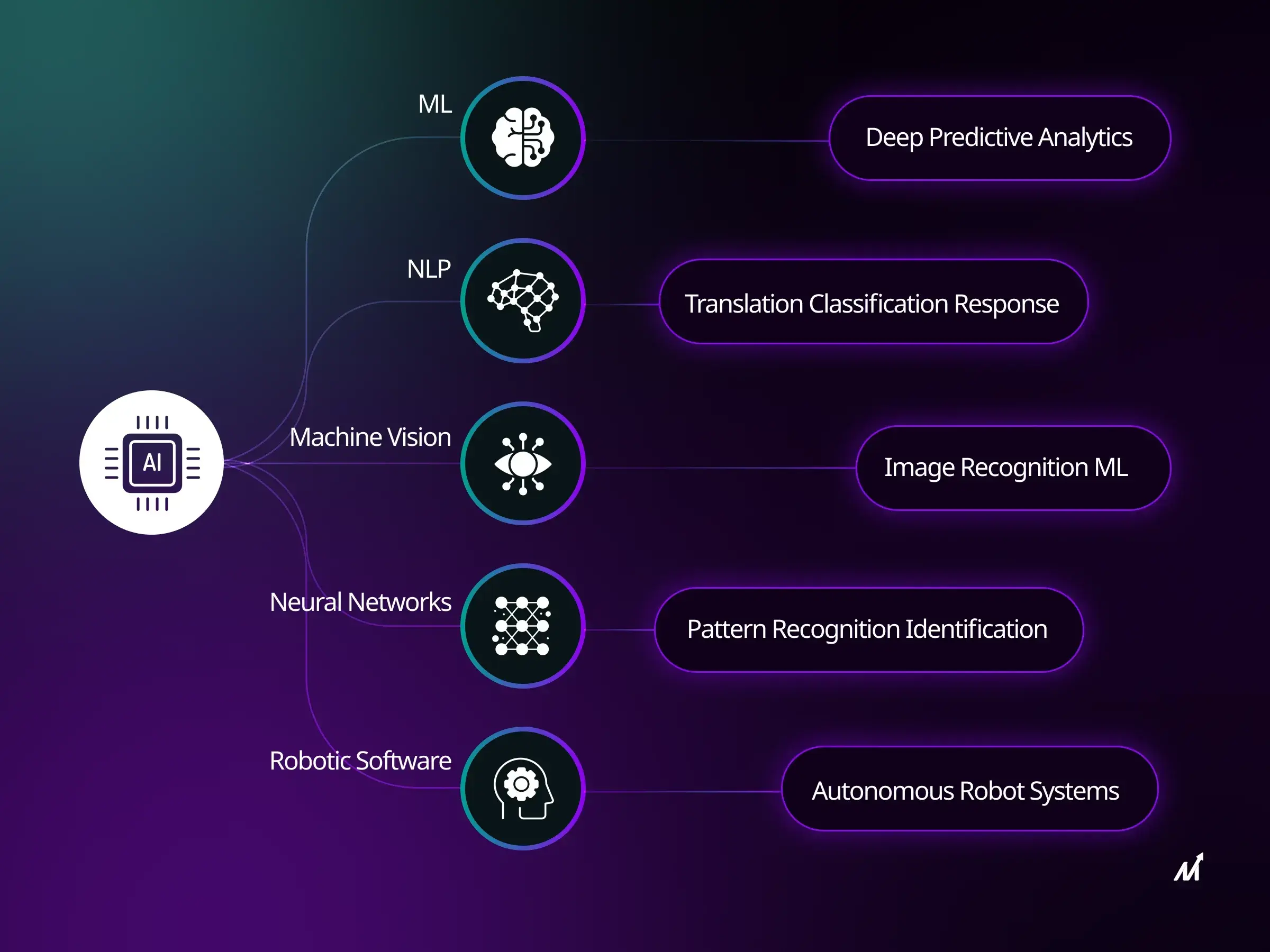Generative AI has emerged as a potent means for inventing fresh solutions and automating various operations in the field of artificial intelligence. This technology leverages advanced machine learning techniques to generate new instances from existing data, enabling businesses to harness the power of Generative AI applications in innovative ways.
Throughout this blog post, we will delve into the intricacies of generative AI systems such as unsupervised machine learning and deep learning with artificial neural networks. We’ll explore how discriminative models differ from their generative counterparts and discuss various applications of large language models in predicting responses and automating communication tasks.
Moreover, you’ll learn about text-to-media transformations using Gen-AI for generating video clips or 3D objects based on textual input. We will also introduce Google Cloud’s Generative AI Solutions that facilitate custom model building through Vertex AI Model Garden and Generative AI Studio. Finally, we’ll examine real-world use cases where generative AI applications transform industries by automating code conversion processes and training machine learning models more efficiently.
Understanding Generative AI
Generative AI is a type of artificial intelligence technology that produces various types of content, including text, imagery, audio, and synthetic data. It uses unsupervised machine learning models to solve problems with unlabeled data and can generate new instances based on existing information.
Unsupervised Machine Learning for Problem-Solving
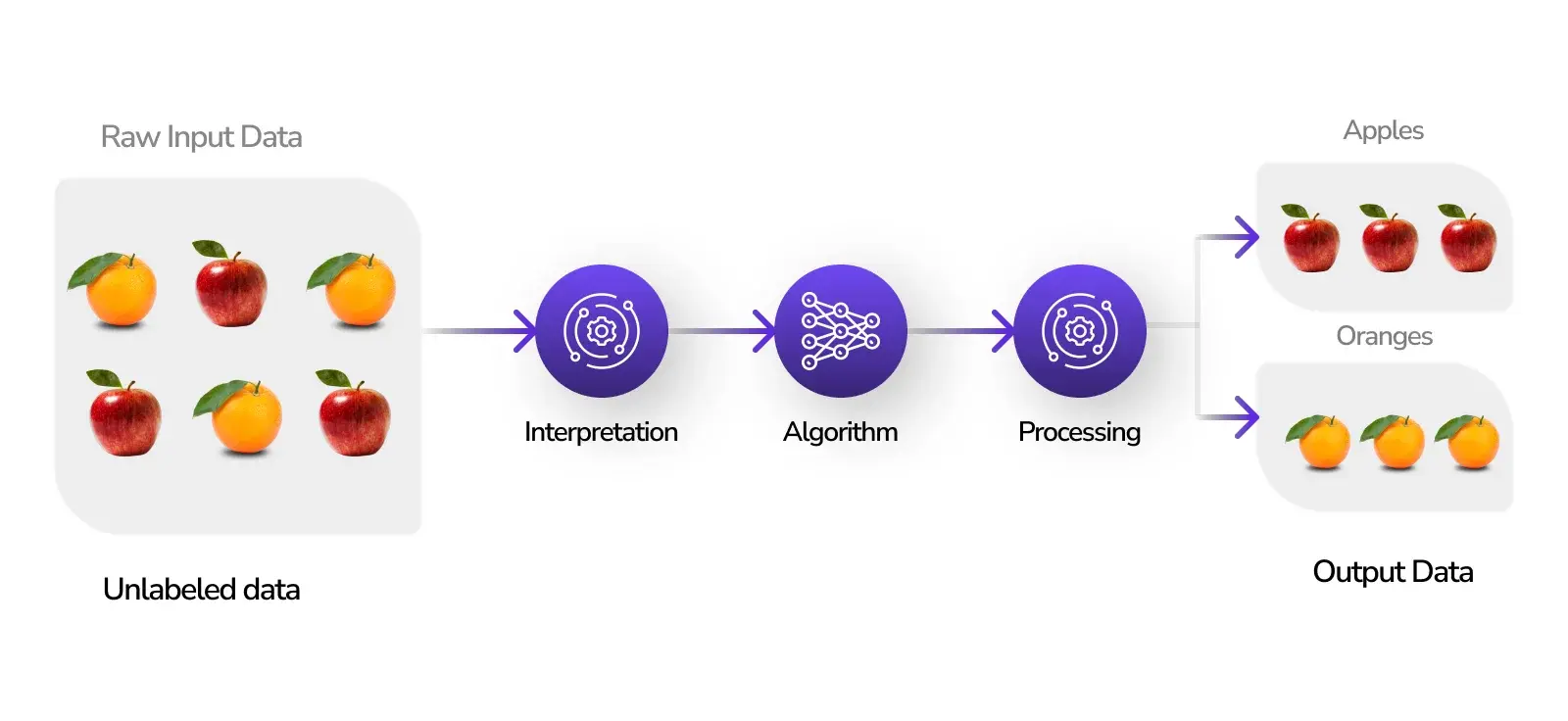
In contrast to supervised learning methods that require labeled training data, generative AI systems rely on unsupervised machine learning, which allows them to identify patterns within large datasets without explicit guidance. This capability enables these models to discover hidden structures in the input data and create novel outputs by understanding intricate relationships between different elements.
Generating New Instances from Existing Data
The core strength of generative AI lies in its ability to produce entirely new content or variations based on the learned representations from existing examples. For instance, stable diffusion algorithms are used in generating images by sampling diverse image distributions while maintaining high-quality results. Similarly, generative adversarial networks (GANs) have been successful in creating realistic human faces or synthesizing artwork inspired by famous artists.
Generative AI holds the promise of revolutionizing problem-solving by leveraging deep learning and artificial neural networks to process complex patterns. Both deep learning and artificial neural networks are integral components in generative AI that can be used to process complex patterns for more efficient results.
Deep Learning and Artificial Neural Networks
Deep learning is an advanced form of artificial intelligence that utilizes artificial neural networks to process more complex patterns than traditional machine learning methods. These networks are the foundation for generative AI models which create novel content by understanding intricate relationships within input data.
Processing Complex Patterns in Deep Learning
In deep learning, algorithms analyze vast amounts of training data, allowing them to recognize and understand complicated patterns. This capacity allows deep learning models to execute undertakings, for example, picture acknowledgment, characteristic language handling and even producing new cases dependent on existing information. The key component behind this technology is the use of artificial neural networks that mimic the human brain’s structure and function.
Role of Artificial Neural Networks in Generative AI
Generative adversarial networks (GANs) are a popular type of generative AI model that leverages artificial neural networks. GANs consist of two interconnected components: a generator network responsible for creating new content, and a discriminator network tasked with distinguishing between real samples from generated ones. By training these two parts simultaneously through competition, GANs can generate high-quality images or other types of media while ensuring their outputs remain consistent with the original dataset.
An example application involving GANs includes stable diffusion-based techniques used to produce realistic images from textual descriptions or random noise inputs.
Deep learning and ANNs have become indispensable for AI applications that generate outputs, providing the capacity to accurately process intricate patterns. Moving on to discuss discriminative vs. generative models, we will explore how classification is done using discriminant analysis as well as content generation through learned representations.
Discriminative vs. Generative Models
Using discriminative models, data instances can be classified based on input features while generative models aim to create new content by learning representations from the existing data. Discriminative models focus on classifying data instances based on input features, while generative models attempt to generate new content by learning representations from the given data.
Classification using discriminant analysis
In a traditional supervised or unsupervised approach, discriminant analysis is used for predicting relationships between input features and labels. For example, in image recognition tasks, a model may be trained to identify specific objects within an image based on their unique characteristics. This type of modeling focuses primarily on classification rather than generating entirely original outputs.
Content generation through learned representations
In contrast with discriminant analysis methods, generative AI systems leverage deep learning techniques like Generative Adversarial Networks (GANs), which learn intricate relationships within training data sets to create novel content that resembles the original inputs but remains distinctively unique. These innovative approaches have led to breakthrough applications such as generating images from text descriptions or even producing stable diffusion processes for molecular simulations.
To harness the full potential of generative AI technologies in your organization’s projects, consider partnering with a top generative ai company like Markovate that specializes in cutting-edge solutions across artificial intelligence (AI), machine learning (ML), Web3, and Mobile domains.
Discriminative models are powerful tools for classifying data, but generative models can be used to generate new content from learned representations. With the power of large language models and Gen-AI, we can now explore how AI applications can automate communication tasks with greater accuracy.
Applications of Generative AI Models
Generative AI has made great progress in the realm of NLP, particularly with the advent of powerful language models that can generate text similar to human speech or predict expected responses from given inputs. These models are capable of predicting expected responses or generating human-like text based on given prompts or questions. As a result, they have found numerous applications across various industries.
Predicting Expected Responses with Large Language Models
GPT-3, one such prominent generative model, can understand and generate contextually relevant responses to user inputs. This capability enables businesses to develop advanced customer support chatbots that offer personalized assistance and improve overall customer experience.
Automating Communication Tasks Using Generative AI
Beyond chatbots, generative AI systems also help automate other communication tasks like email replies and content generation for social media posts. For instance, OpenAI’s API allows developers to integrate GPT-3 into their applications for automating these processes while maintaining a high level of quality and coherence in generated outputs.
- Email automation: Automatically generate concise yet informative email replies by understanding the context from received emails.
- Social media content: Generate engaging captions or post ideas tailored to specific audiences based on keywords provided by users.
- Data summarization: Summarize lengthy documents into shorter versions without losing critical information using advanced text compression techniques powered by generative AI models.
Incorporating generative AI models into your business operations can lead to increased efficiency and enhanced customer satisfaction through automated communication solutions tailored specifically to your target audience.
Generative language models predict responses and automate communication tasks, making them invaluable assets for any business. By leveraging Gen-AI technology, we can now transform text into media such as videos or 3D objects with ease.
Text-to-Media Transformations with Generative AI
Generative AI transforms text into various media formats, including video clips and 3D models. AI-driven technologies let creative professionals realize their visions without extensive manual design work.
Generating Video Clips from Textual Descriptions
One of the fascinating capabilities of generative AI systems is their ability to generate video content based on textual input. Generative adversarial networks (GANs) analyze natural language to create realistic visuals matching the given context. This process not only saves time but also allows creators to experiment with different concepts effortlessly.
Creating 3D Objects Using Text Input
Beyond generating videos, generative AI can also produce three-dimensional objects using textual descriptions as a starting point. For instance, researchers have developed DALL-E, an AI model capable of creating unique images by interpreting text prompts accurately. Generative AI models like Stable Diffusion Transformers help design virtual environments and prototype products without extensive modeling skills.
Incorporating generative techniques speeds up visualization and iteration, reducing resource-intensive tasks in traditional design processes.
Text-to-Media Transformations with Gen-AI have the potential to revolutionize how we create media, from 3D objects to video clips. With Google Cloud’s Generative AI Solutions, businesses can explore and build custom solutions that are tailored for their needs.
Google Cloud’s Generative AI Solutions
Google Cloud provides a suite of AI solutions to enable businesses to construct custom, tailored models for their operations. By leveraging these cutting-edge technologies, organizations can drive innovation and streamline processes across various domains.
Exploring Generative Models in Vertex AI Model Garden
Vertex AI Model Garden is a collection of pre-trained foundation models that cater to chat and text applications. Generative adversarial network-based models let developers quickly prototype or integrate AI capabilities with minimal training data.
Building Custom Solutions with Generative AI Studio and App Builder
Beyond the Model Garden, Google Cloud provides Generative AI Studio, an environment for customization and exploration of generative AI systems. This platform allows users to fine-tune pre-trained AI models or develop entirely new ones using state-of-the-art techniques like stable diffusion.
- Create Images: Generate images based on textual descriptions or visual inputs by utilizing advanced deep learning algorithms.
- Synthesize Audio: Produce realistic audio clips from text input through sophisticated speech synthesis technology.
- Data Augmentation: Enhance datasets with synthetic examples generated by generative AI, improving model performance without manual data collection efforts.
Google Cloud’s no-code App Builder lets non-technical users create AI-powered applications without coding. This democratizes access to cutting-edge technologies, fostering innovation across various industries.
Google Cloud’s Generative AI Solutions offer tools to help organizations create custom solutions for their unique needs. Gaining knowledge of how generative models are being employed in the present day can be done by investigating actual applications.
Real-world Use Cases of Generative AI
Generative AI technologies are transforming industries by automating repetitive tasks and providing creative insights that drive innovation across multiple domains. In this part, we’ll examine two examples of how generative AI has had a major effect.
Automating Code Conversion Processes
Markovate uses generative adversarial networks to automate converting code files, like pandas data frames, into JSON format. This not only saves time for developers but also reduces the chances of errors during manual conversions. By leveraging generative adversarial networks (GANs), Markovate can streamline its software development process while maintaining high-quality outputs.
Training Machine Learning Models Efficiently
Another example is training machine learning models using various algorithms through Google’s Palm API. Generative AI systems provide large training datasets, allowing ML engineers to train models without manual data collection or labeling. The Google Cloud Vertex Pipelines allow users to build end-to-end workflows for deploying and managing these complex ML models with ease.
In both cases, generative AI is invaluable for businesses aiming to enhance efficiency and stay competitive.
The Future with Generative AI
Generative AI is set to reshape the world of business, bringing new methods and opportunities across different sectors. Here’s how:
- Custom-Made Marketing: Generative AI is a game-changer in creating personalized marketing strategies. These algorithms look closely at customer data to develop marketing efforts that feel personal to each individual. As a result, more customer engagement, more sales, and stronger customer loyalty.
- Product Creation and New Ideas: Generative AI doesn’t just analyze data; it helps create new products. Machine learning helps businesses explore designs to find innovative ideas that align with their brand and meet customer needs. Consequently, the result is a lineup of unique products that catch the customer’s eye and give the business a competitive edge.
- Data Insights: With the huge amount of data available today, finding useful information is like finding a needle in a haystack. However, generative AI automates sorting through data to identify useful trends and patterns. This helps businesses make informed decisions, run things more efficiently, and outdo competitors.
- Better Customer Service: Generative AI also improves the way businesses interact with customers. Using Natural Language Processing, AI-powered chat services provide personalized, human-like customer support any time of day. Furthermore, these services answer customer questions and predict future needs, ensuring a smooth and enjoyable experience.
The benefits of using generative AI in business are clear:
- Better content creation
- Innovative product designs
- Efficient handling of big data
- More effective marketing efforts
- Improved customer interactions
- Greater overall efficiency
- Staying ahead of competitors
- Preparing for the future
Generative AI is a strategic asset offering significant advantages across all business areas. In essence, it’s about creating a game-changing impact that can redefine business operations, not just making small improvements.
FAQs – Generative AI Applications
What are Generative AI Applications?
Generative AI applications use models to create new content based on existing data. For instance, these applications include natural language processing, image and video generation, 3D object creation, and more. They use deep learning techniques like unsupervised learning and neural networks to process complex patterns.
What are Real-World Applications for Generative AI?
Real-world applications for generative AI span across various industries like marketing, entertainment, healthcare, and design. Specifically, examples include personalized ads, realistic images from text, 3D object design, automated tasks, efficient ML models, and code conversion.
What is the Most Famous Generative AI?
OpenAI’s GPT-2, known for generating human-like text, gained fame for its impressive capabilities. GPT-3, an advanced version, improved performance in translation, summarization, question answering, and more.
What are the Problems with Generative AI?
Generative AI faces challenges like ethical concerns over fake content, biases in training data, and unintended consequences from misuse. Moreover, these models need substantial computational resources for training and deployment, limiting accessibility for smaller organizations or individuals.
Conclusion
Generative AI applications are revolutionizing the way we solve complex problems and generate new instances from existing data. In addition, unsupervised ML, deep learning and ANNs can form classifying models or learn representations to generate new material.
Generative AI transforms text into 3D objects, automates communication tasks, and predicts responses with large language models. Similarly, Google Cloud’s Generative AI Solutions include Vertex AI Model Garden, Generative AI Studio, and App Builder for custom models.
To take advantage of these powerful tools for your business needs, contact us today for a consultation on how our team at Markovate can help you leverage Generative AI Applications to achieve your goals.

